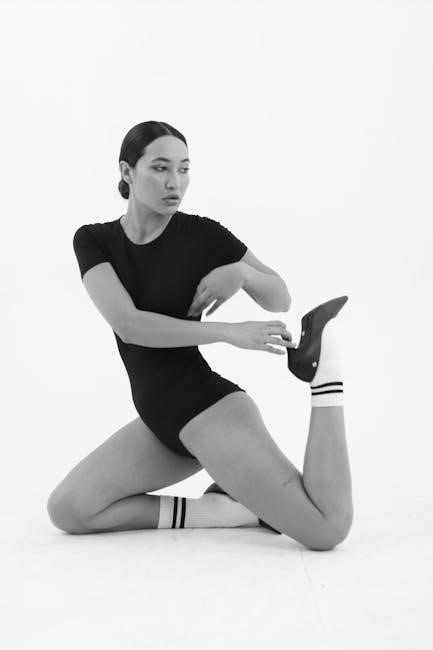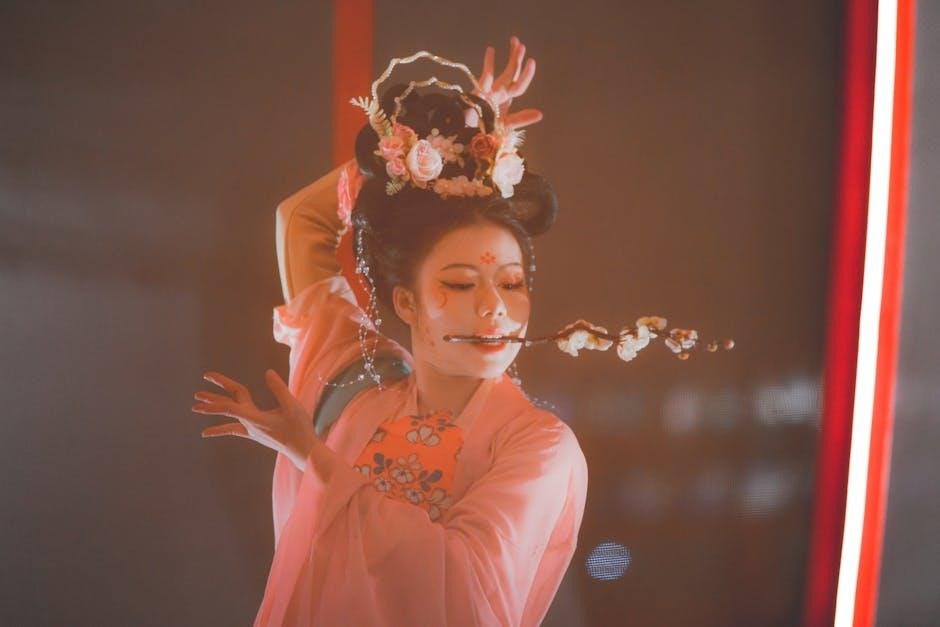Yang Style Tai Chi is a traditional martial art emphasizing slow, flowing movements for physical and mental well-being. Its 108-movement form, refined by Yang Cheng-fu, combines graceful techniques with deep breathing to promote relaxation and energy flow. The sequence, rooted in Chinese philosophy, is practiced globally for its health benefits, including improved balance, strength, and mental clarity. PDF guides and tutorials are widely available, offering detailed instructions for mastering this iconic form.
1.1 History and Development of Yang Style Tai Chi
Yang Style Tai Chi, developed by Yang Lu Chan (Yang Wu Di), evolved from Chen Style Tai Chi in the 19th century. Yang Lu Chan refined the movements, making them larger and slower, emphasizing health benefits. His grandson, Yang Cheng-fu, standardized the form in the 1930s, creating the well-known 108-movement sequence. This adaptation made Yang Style accessible to the public, spreading its practice globally. The form blends martial techniques with meditative principles, reflecting Chinese cultural and philosophical traditions. Today, Yang Style remains one of the most practiced Tai Chi forms worldwide, cherished for its elegance and holistic benefits. PDF guides detail its history and movements.
1.2 Key Characteristics of Yang Style Tai Chi
Yang Style Tai Chi is distinguished by its expansive, fluid movements that emphasize balance and harmony. The form features large, circular motions and a focus on proper body alignment. Movements are performed slowly and continuously, fostering relaxation and energy circulation. The 108-movement sequence is structured into three sections, each with distinct techniques that build upon one another. Key elements include the integration of yin-yang principles, soft power, and internal energy (qi). The practice is accessible to all ages, promoting physical health, mental clarity, and spiritual well-being. Detailed PDF guides outline the sequence and techniques, aiding practitioners in mastering the form’s unique characteristics.
1.3 Importance of the 108 Movements
The 108 movements in Yang Style Tai Chi represent a harmonious blend of martial techniques and meditative practices. This comprehensive sequence is designed to cultivate balance, strength, and inner energy. Each movement flows seamlessly into the next, promoting continuous energy circulation and mental focus. The 108 movements are considered foundational, teaching proper alignment, breathing, and relaxation. They integrate physical postures, transitions, and philosophical principles, offering a holistic practice for health and self-cultivation. PDF resources detail each movement, enabling learners to follow the sequence accurately and benefit from its profound physical, mental, and spiritual rewards.

Structure of the 108 Movements
The 108 movements are divided into three main sections, each ending with a return to Wu Chi posture. The sequence flows smoothly, emphasizing balance and energy circulation, creating a meditative and physically engaging practice that unifies body and mind.
2.1 Division into Sections
The 108 movements are traditionally divided into three distinct sections, each concluding with a return to the Wu Chi stance. This structure ensures a balanced progression, allowing practitioners to gradually build skill and understanding. The first section introduces foundational movements, the second expands on techniques, and the third incorporates advanced methods. Each section seamlessly transitions to the next, maintaining the form’s fluidity and meditative essence. This division encourages a holistic practice, integrating physical postures with mental focus and breath control, fostering overall well-being and mastery of the art.
2.2 Sequence and Flow of Movements
The 108 movements follow a logical sequence, blending strength and softness in a harmonious flow. Each movement transitions smoothly to the next, maintaining balance and continuity. The form begins with foundational postures like Grasp Birds Tail and Single Whip, progressing through expansive techniques such as White Crane Spreads Wings and Brush Knee. Advanced movements like Retreat to Ride Tiger and Shoot Tiger With Bow refine skill and precision. The sequence emphasizes alignment, relaxation, and internal energy, fostering a meditative state. This structured flow allows practitioners to cultivate mindfulness and unity of body and mind, embodying the essence of Tai Chi philosophy.
2.3 Transition Between Movements
Transitions in the 108 movements are seamless, with each posture flowing naturally into the next. Techniques like Grasp Birds Tail and Single Whip connect through subtle weight shifts and rotational movements. The form employs principles of continuity and fluidity, ensuring that energy flows without interruption. Proper alignment, balance, and relaxation are maintained during transitions, allowing for efficient energy conservation. These smooth shifts enhance the meditative experience and embody the Tai Chi principle of soft power. Practitioners aim to execute transitions with grace and precision, reflecting the art’s emphasis on harmony and inner balance.

First Section: Opening and Foundation Movements
This section introduces foundational techniques, beginning with Wu Chi, the starting posture. It progresses through Grasp Birds Tail and Single Whip, establishing the form’s rhythmic flow and balance.
3.1 Opening Form (Wu Chi)
The Opening Form, or Wu Chi, is the starting posture of the Yang Style Tai Chi 108-movement sequence. It begins with a standing position, feet together, arms relaxed by the sides, and a calm, centered mindset. The practitioner visualizes the Wu Chi state, symbolizing infinity and the origin of movement. This posture prepares the body and mind for the flowing sequence ahead.
The movement transitions into raising the arms, extending the hands, and lowering them to the starting position. This initial sequence sets the tone for balance, relaxation, and energy flow, essential for executing the subsequent movements effectively. The Wu Chi stance is a foundation for harmony and focus in Tai Chi practice.
3.2 Grasp Birds Tail and Ward-off Movements
The Grasp Birds Tail sequence is a foundational movement in the Yang Style Tai Chi 108 form. It begins with a left ward-off, followed by rolling back, pressing, and pushing. This sequence emphasizes balance, coordination, and the harmonious flow of energy. The ward-off movement involves raising the hands and stepping forward, while the roll-back movement requires a soft, yielding action. Together, these actions demonstrate the principle of blending with an opponent’s energy before countering with a gentle yet firm response. Practitioners are encouraged to maintain relaxation and synchronization between body and breath throughout the sequence.
These movements are essential for cultivating internal energy and improving overall physical and mental alignment. They are often practiced repeatedly to refine technique and deepen understanding of Tai Chi principles.
3.4 Single Whip and Its Significance
The Single Whip is a dynamic movement in the Yang Style Tai Chi 108 form, characterized by a whip-like action of the arm and a coordinated weight transfer. It involves extending one arm while rotating the torso, creating a flowing, energetic transition. This movement is often used to conclude or transition between sequences, emphasizing balance, power, and fluidity. The Single Whip is significant for its ability to cultivate internal energy and improve coordination, while its whip-like motion symbolizes both power and grace. Proper alignment and relaxation are key to executing this movement effectively, making it a cornerstone of Tai Chi practice.

Second Section: Expanding Techniques
This section introduces intermediate techniques, building on foundational movements. It includes White Crane Spreads Wings, Brush Knee, and Strum the Pei Pa, enhancing flow and balance.
4.1 White Crane Spreads Wings
The White Crane Spreads Wings movement embodies grace and precision, mimicking a crane extending its wings. Practitioners stand tall, arms unfolding like wings, emphasizing balance and fluidity. This technique, part of the second section, trains coordination and inner energy flow. Proper alignment and relaxation are crucial, allowing the movement to feel natural and effortless. As described in various PDF guides, this posture strengthens the upper body and improves posture. It symbolizes freedom and lightness, reflecting Tai Chi’s blend of martial and meditative elements. Regular practice enhances both physical and mental poise, making it a cornerstone of the Yang Style form.
4.2 Brush Knee and Twist Step
Brush Knee and Twist Step is a dynamic movement in Yang Style Tai Chi, combining defensive and offensive techniques. It involves brushing the knee with one hand while twisting the step, shifting weight from one leg to the other. This movement enhances balance, coordination, and agility. Proper execution requires relaxation, smooth transitions, and synchronization of hand and foot movements. As detailed in PDF guides, it strengthens the legs and improves overall stability. Practitioners are encouraged to focus on proper alignment and flow, making it a vital part of the sequence for both physical exercise and martial application, promoting holistic well-being and discipline.
4.3 Strum the Pei Pa and Its Variations
Strum the Pei Pa is a distinctive movement in Yang Style Tai Chi, characterized by intricate hand techniques mimicking the plucking of a lute. It involves circular motions of the hands, combining soft and firm energies. Variations include forward and backward strumming, emphasizing balance and fluidity. This movement enhances dexterity, coordination, and internal energy flow. As detailed in PDF guides, proper execution requires precise weight transfer and body alignment. Strum the Pei Pa not only showcases artistic expression but also embodies the philosophical principles of Tai Chi, blending offense and defense seamlessly. Practitioners find it a rewarding movement for both physical and mental cultivation, promoting harmony and focus.

Third Section: Advanced Techniques
This section introduces complex movements like Retreat to Ride Tiger and Shoot Tiger With Bow, requiring precise coordination, balance, and mastery of internal energy flow.
5.1 Retreat to Ride Tiger
Retreat to Ride Tiger is an advanced movement in the Yang Style Tai Chi 108 form, emphasizing balance, coordination, and strategic retreat. It involves shifting weight onto the back leg while turning the torso, creating a powerful defensive posture. The movement transitions smoothly from the previous sequence, requiring precise control and internal energy. Practitioners must focus on proper alignment, soft power, and fluidity to execute it effectively. This technique enhances overall stability and prepares for subsequent offensive actions, embodying the philosophy of yielding to overcome. It is a cornerstone of advanced Tai Chi practice, fostering mastery of transitions and energy redistribution.
5.2 Shoot Tiger With Bow
Shoot Tiger With Bow is a dynamic movement in the Yang Style Tai Chi 108 form, combining precision and power. It involves a deep stance, with the back leg firmly rooted and the front leg slightly bent. The arms extend as if holding a bow, with one hand drawing the string back toward the anchor point. This movement requires coordination between the hands, eyes, and waist, emphasizing concentration and focus. It symbolizes the release of stored energy, blending softness with explosive power. Proper alignment and timing are crucial to capture the essence of this technique, which is both a defensive and offensive maneuver in the sequence.
5.3 Conclusion of Tai Chi Chuan
The Conclusion of Tai Chi Chuan marks the completion of the Yang Style 108-movement form. This final movement, often referred to as “Close Tai Chi,” brings the practitioner back to the starting position, symbolizing the return to stillness. The arms are lowered, and the hands come together in a resting position, mirroring the initial Wu Chi stance. This movement emphasizes the cyclical nature of Tai Chi, where the end connects seamlessly with the beginning. It serves as a moment of reflection, allowing the practitioner to consolidate the energy cultivated during the sequence. Proper execution ensures a smooth transition, leaving the practitioner centered and balanced.
Key Movements and Techniques
Key movements in Yang Style Tai Chi include Grasp Birds Tail, Single Whip, and Cloud Hands. These techniques emphasize balance, inner energy, and fluid transitions, reflecting the harmony of yin and yang.

6.1 Grasp Birds Tail and Roll Back
Grasp Birds Tail and Roll Back are foundational movements in Yang Style Tai Chi, emphasizing fluid transitions and balance. Grasp Birds Tail involves extending the arms and shifting weight, mimicking the action of holding a bird’s tail, while Roll Back combines a backward step with a circular hand movement, symbolizing yielding and soft power. These techniques improve coordination, posture, and inner energy flow. They are typically performed in sequence, showcasing the harmonious integration of movement and breath. Practitioners benefit from enhanced relaxation, reduced tension, and improved overall well-being through consistent practice of these movements.
6.2 Press and Push Movements
Press and Push Movements are integral techniques in Yang Style Tai Chi, emphasizing the application of precise timing and balance. These movements involve extending the arms and using the entire body to generate power, rather than relying solely on arm strength. The Press movement is characterized by a forward-pushing action, while the Push movement involves a gentle yet firm extension of energy. Both techniques are designed to cultivate internal energy (Qi) and improve coordination. Proper execution requires alignment of the hands, waist, and legs. These movements are essential for developing relaxation, balance, and the ability to direct energy effectively during practice;
6.3 Single Whip and Cloud Hands
Single Whip and Cloud Hands are two of the most iconic movements in the Yang Style Tai Chi 108 form. The Single Whip involves a dynamic transition from a static position to a whipping motion, showcasing fluidity and balance. Cloud Hands, characterized by circular, flowing arm movements, embodies the soft and yielding aspects of Tai Chi. Together, these techniques exemplify the harmony between strength and softness, emphasizing relaxation and the continuous flow of energy. They are essential for refining coordination, balance, and the ability to seamlessly transition between movements, making them cornerstone techniques in the Yang Style curriculum.

Benefits of Practicing the 108 Movements
Practicing the 108 movements enhances balance, strength, and coordination while reducing stress. It promotes relaxation, mental clarity, and overall well-being, suitable for all ages and skill levels.
7.1 Physical Benefits
Yang Style Tai Chi’s 108 movements offer numerous physical benefits. Regular practice enhances balance, flexibility, and strength, particularly in the arms, legs, and core. Improved posture and coordination are also common. The slow, flowing movements increase circulation, reducing stiffness and joint pain. Tai Chi is low-impact, making it accessible for people with mobility challenges. Additionally, it aids in weight management and improves cardiovascular health. Over time, practitioners often experience better overall physical fitness and reduced risk of injuries, especially in older adults. The movements also strengthen the immune system and promote longevity through consistent practice.
7.2 Mental and Emotional Benefits
Yang Style Tai Chi’s 108 movements foster mental clarity and emotional well-being. The meditative nature of the practice reduces stress and anxiety, promoting relaxation. By focusing on slow, deliberate movements, practitioners improve concentration and mindfulness. The flowing sequences encourage a sense of calm and emotional balance. Regular practice helps alleviate depression and enhances overall mental health. The discipline required to master the form builds self-discipline and confidence. Over time, the harmonization of body and mind leads to a deeper sense of inner peace and emotional stability, making it a holistic practice for mental and emotional wellness.
7.3 Spiritual and Energetic Benefits
Yang Style Tai Chi’s 108 movements cultivate spiritual growth and energetic harmony. The practice enhances the flow of Qi, or life energy, promoting vitality and inner balance. By aligning movements with breath and intention, practitioners connect with their inner selves, fostering a sense of unity and spiritual awareness. The sequences are deeply rooted in Taoist philosophy, emphasizing harmony with nature and the universe. Regular practice is believed to open energy channels, leading to improved circulation and a stronger life force. This holistic approach nurtures both the spirit and body, creating a path to enlightenment and profound inner peace through mindful movement.
Learning the 108 Movements
Mastering the Yang Style Tai Chi 108 movements requires patience and dedication. Start with a step-by-step guide, focusing on proper alignment and fluid transitions. Practice slowly to ensure precision, gradually increasing speed as confidence grows. Utilize online resources, such as PDF guides and video tutorials, to refine techniques. Consistency is key to mastering this intricate form, which combines physical movement with mental focus and energy flow.
8.1 Step-by-Step Guide
Learning the Yang Style Tai Chi 108 movements begins with the opening form, Wu Chi, emphasizing relaxation and proper posture. Start by standing tall with feet together, arms relaxed, and focus on deep breathing. Progress through foundational movements like Grasp Birds Tail and Single Whip, paying attention to alignment and flow. Break the form into sections to master each sequence gradually. Practice transitions smoothly, ensuring continuity between movements. Utilize PDF guides and video tutorials for visual cues and detailed instructions. Consistency is key; practice regularly, even for short periods, to build muscle memory and refine technique over time.
8.2 Common Mistakes to Avoid
- Rushing through movements: Tai Chi requires slow, controlled actions to ensure balance and harmony.
- Stiffness: Maintain relaxation in the shoulders and arms to allow natural flow.
- Incorrect posture: Poor alignment can lead to discomfort and improper technique.
- Forgetting to breathe: Deep, natural breathing is essential for energy flow and relaxation.
- Improper hand-foot coordination: Ensure movements are synchronized to maintain the form’s integrity.
8.3 Tips for Effective Practice

Start with a strong foundation by mastering basic movements like Wu Chi and Grasp Birds Tail. Use online tutorials or PDF guides to ensure proper form. Practice slowly to develop balance and coordination. Focus on deep, natural breathing to enhance energy flow. Regular practice, even for short sessions, improves retention. Seek feedback from instructors to correct mistakes. Stay relaxed and avoid stiffness, allowing movements to flow naturally. Incorporate mindfulness to connect with the philosophical roots of Tai Chi. Consistency is key to progressing through the 108 movements effectively.

Cultural Significance
Yang Style Tai Chi is a beloved tradition, reflecting Chinese philosophy and martial arts heritage. Practiced globally, it promotes health, harmony, and spiritual growth, embodying cultural values deeply rooted in history and philosophy.
9.1 Historical Context
Yang Style Tai Chi traces its origins to Yang Lu Chan (Yang Wu Di), a 19th-century martial artist, who refined the art into its distinctive slow, flowing form. His grandson, Yang Cheng-fu, popularized it in the early 20th century, adapting it for broader practice and health benefits. Rooted in Taoist philosophy, the form embodies the harmony of yin and yang, reflecting ancient Chinese cultural values. The 108 movements, embodying both martial and healing aspects, were structured to promote internal energy flow and balance. This tradition has evolved into a global practice, preserving its historical essence while adapting to modern lifestyles.
9.2 Philosophical Roots
Yang Style Tai Chi is deeply rooted in Taoist philosophy, emphasizing harmony with nature and the balance of opposites (yin and yang). The practice reflects the concept of Wu Chi, the infinite potential from which all things arise, and the cyclical nature of movement. Inspired by the Tai Chi Classics, it embodies principles like “softness overcoming hardness” and “stillness within motion.” The form cultivates internal energy (Chi) and its circulation, aligning with the Taoist pursuit of bodily and spiritual unity. This philosophical foundation transforms Tai Chi into a holistic practice, blending martial technique with meditative introspection and a connection to universal harmony.
9.3 Modern Applications
Yang Style Tai Chi has evolved into a global practice, embraced for its health benefits and therapeutic value. It is widely used in fitness, rehabilitation, and stress relief programs. Many modern instructors integrate the 108-movement form into holistic wellness routines, emphasizing its ability to improve balance, flexibility, and mental clarity. The form’s slow, meditative movements make it accessible to people of all ages and fitness levels. PDF guides and online tutorials have further popularized the practice, allowing individuals to learn and practice independently. Its adaptability ensures Yang Style Tai Chi remains a relevant and transformative practice in contemporary society.
Yang Style Tai Chi’s 108 movements offer a comprehensive practice blending martial arts with meditation. It enhances physical health, mental clarity, and spiritual balance, making it a timeless art form. The availability of PDF guides and tutorials ensures accessibility for learners worldwide. Embrace this journey to cultivate inner peace and holistic well-being through consistent practice and dedication.
10.1 Summary of Key Points
The Yang Style Tai Chi 108 movements form a comprehensive sequence emphasizing balance, harmony, and internal energy. Rooted in traditional martial arts, it combines slow, flowing techniques with deep breathing to promote physical and mental well-being. Divided into three main sections, the form progresses from foundational movements to advanced techniques, culminating in a meditative conclusion. Historical development by Yang Cheng-fu refined the practice, making it accessible worldwide. Key benefits include improved balance, strength, and mental clarity. PDF guides and video tutorials provide detailed instruction, aiding learners in mastering this timeless art. Consistent practice fosters holistic health and spiritual growth, aligning with Tai Chi’s philosophical roots.
10;2 Encouragement for Further Practice
Embrace the journey of Yang Style Tai Chi by committing to regular practice, as consistency is key to mastering the 108 movements. Each movement nurtures balance, strength, and mental clarity, offering holistic benefits for body and mind. As you progress, explore the philosophical depths and spiritual connections inherent in the form. Utilize available PDF guides and video tutorials to refine your technique and deepen your understanding. Remember, Tai Chi is a lifelong path of growth and self-discovery. Stay dedicated, and let the practice enrich your life with harmony, energy, and peace. Keep exploring, learning, and enjoying the transformative power of Tai Chi.

Additional Resources
Explore detailed PDF guides, video tutorials, and downloadable materials to deepen your understanding of the Yang Style Tai Chi 108 movements. These resources offer step-by-step instructions, movement breakdowns, and philosophical insights to enhance your practice and mastery of the form.
11.1 Recommended Reading
For deeper insights, explore books like “Yang Style Taijiquan” by Yang Cheng-fu and “Mastering Yang Style Taijiquan” by Fu Zhongwen. These classics provide detailed movement analysis and historical context. Additionally, “The Essence of Tai Chi” by Yang Jun offers modern perspectives; Online resources include PDF guides from the Living Younger Longer Institute and detailed movement lists from Inner Circle Academy. These materials complement practice, offering step-by-step instructions and philosophical insights. They are ideal for both beginners and advanced practitioners seeking to refine their understanding of the 108-movement form.
11.2 Video Tutorials and Guides
Enhance your practice with video tutorials available on platforms like YouTube and specialized Tai Chi websites. Channels such as “Yang Style Tai Chi Academy” and “Tai Chi Foundation” offer detailed breakdowns of the 108 movements. Websites like 21stcenturytaichi.com provide step-by-step guides, while others feature demonstrations by renowned instructors. These resources are ideal for visual learners, offering real-time instruction and corrections. Many videos include commentary on proper posture, breathing, and energy flow, making them invaluable for both beginners and advanced practitioners. They complement written guides, helping to refine technique and deepen understanding of the form.
11.3 Downloadable PDFs
Downloadable PDFs are excellent resources for mastering the Yang Style Tai Chi 108 movements. Documents like the “Yang Style Taijiquan Long Form 108” by Michael P. Garofalo and “Yang Style Tai Chi Chuan Traditional 108-Movement Long Form” provide detailed movement descriptions. Websites such as innercircleacademy.com.au and taichidenver.com offer free PDFs with step-by-step instructions, movement names, and illustrations. These guides are ideal for self-study, offering clear instructions and visual aids. Many PDFs include Chinese names, pinyin, and English translations, making them accessible to a global audience. They are invaluable for both beginners and advanced practitioners seeking to refine their techniques and deepen their understanding of the form.
